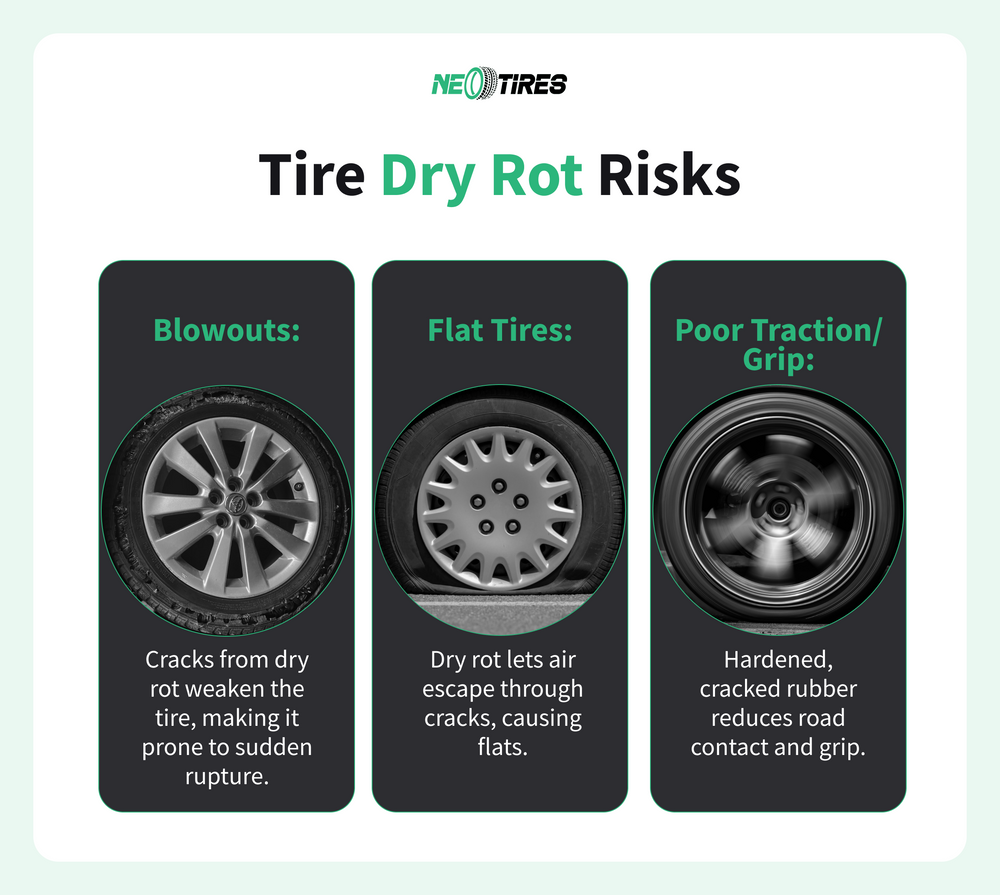Tire dry rot is the deterioration of the rubber in a tire that occurs due to external factors, including exposure to sunlight, extreme weather conditions, and aging. Dry rot manifests through cracks in rubber, brittleness, and overall weakening, posing a safety hazard due to the risk of tire failure and blowouts. NHTSA recommends tire replacement when symptoms of dry rot, such as brittle sidewalls and hard texture, appear.
This article explores what dry rot is and the factors that contribute to its development. Drivers will learn about the risks associated with sidewall weathering and how to prevent dry rot development, ensuring their safety on the road.
What Is Tire Dry Rot?
Tire dry rot is the structural degradation of the sidewall’s exterior, causing the rubber to dry out excessively and become brittle. Drying and cracking of the sidewall indicate that rubber compounds lose their flexibility, weakening the overall tire integrity.
Weather cracking means reduced grip and increased risk of tire failure for the driver. Cooper Tires defines dry rot as when a tire presents signs of splitting and cracking in the sidewall and tread pattern (in severe cases) with a greying or fading look.
8 Factors Causing Tire Dry Rot (Sidewall Weathering)
8 factors leading to sidewall weathering include:
- Excessive exposure to heat and UV light
- Excessive exposure to freezing temperatures
- Improper tire storage
- Excessive use of petroleum-based chemicals
- Underinflation
- Exposure to electric motors or other ozone-generating sources
- Natural aging
- Long-term parking (weeks and months of driving inactivity)
Tire Dry Rot Risks: How Sidewall Weathering Can Affect Driving
Driving on dry-rotted tires is risky because dried-out and cracked rubber can lead to blowouts, flat tires, poor traction, and grip.
Tire brittleness can lead to a blowout because the cracks in the rubber structure weaken it under heat and pressure. Blowouts can pose a threat to the vehicle owner if he can’t properly manage the sudden tire failure.
Rubber fissures caused by dry rot allow air to leak slowly or rapidly, causing a flat tire. Driving on a flat tire can make the vehicle owner lose stability and steering control.
Traction and grip can become poorer because the rotted rubber loses flexibility and struggles to maintain proper contact with the road. Acceleration, cornering, and braking become risky with tire dry rot, especially on wet roads.
7 Steps To Prevent Tire Dry Rot
The following seven steps help drivers prevent their tires from dry rotting:
- Reducing exposure to heat and UV lights, especially in the summer, by parking in shade and/or using tire covers
- Keeping proper tire pressure according to the manufacturer’s recommendations
- Ensuring proper maintenance by cleaning tires during car washes (removing road grime and dirt residues ), avoiding petroleum-based chemicals
- Storing tires in a dry and well-ventilated place, at a constant temperature between 45°F and 68°F
- Driving tires regularly, or taking short drives when regular driving is not possible
- Inspecting tires regularly by checking for discoloration, cracks, separation, or weathering spots
- Avoiding extra load as extra pressure speeds up rubber drying if combined with UV exposure
Signs of Tire Dry Rot
A tire is likely developing dry rot if:
→ The sidewall shows small or large, deep or shallow cracks.
→ The tire color turns gray, or the rubber black color fades to chalky white.
→The structure of the sidewall and/or tread starts flaking, becoming brittle, and losing flexibility.
→The tire pressure drops quickly or slowly, even if the driver constantly adjusts it.
Dry Rot In Your Tires?
Visit the NeoTires catalog if your tires are showing signs of dry rot. Choose products based on your vehicle, size, brand, or tire type, and we'll deliver your tires quickly to your home or a nearby installation center, anywhere in the U.S. Get free, professional guidance via chat, call, or text. Our assistants are ready to tailor the right tires to your needs. Drive safe and choose your tires wisely!







